Hi all. I’m Skyler, an incoming senior at the Telluride High School. Thanks to the Pinhead Institute, I get to spend the majority of my summer in Tempe, Arizona, developing a fascination with some really old rocks. And by really old, I mean just shy of being as old as the earth itself, dating back to around two to three billion years old.
Although I was sent to Arizona State University following my passion for space lived through astrobiology, I have found that instead I am working in a lab along side geochemists. I have no complaints however, everyone in the Anbar lab is very welcoming and my mentor Chad Ostrander, is not only extremely nice, but very patient with a newcomer such as myself.
Here is a breakdown of the science I am assisting Chad with:
Oxygen is essential for life development on Earth, that much we know. Throughout the course of time, oxygen was not always prevalent. However, prior to the Great Oxidation Event, a large spike in oxygen in earth’s atmosphere about 2.3 billion years ago, there was oxygen. So of course, the question is why? By tracing the element molybdenum in shale sediments there may be an answer. Molybdenum (Mo) isotopes are abundant in oxygen rich waters, but in euxinic waters (little to no oxygen) the molybdenum sinks to the bottom and joins the sediment. Therefore, we examine the sediments at the bottom of euxinic pools looking for Mo isotopes to give us clues to the oxygen content at these time periods. Looking at molybdenum in the shale will help scientists better understand the evolution of life from oxygen on our planet, and to future worlds to come. To figure out the Mo content, there is quite a bit of chemistry and mass spectrometry involved.
This week I assisted Chad on proving/disproving a procedure for separating the shale sediments residing in euxnic pools from the weathered continental crust sediment that combines with the shale. The procedure involved making a synthetic combination of continental crust to shale rock ratios with known Mo isotope concentrations. Then, we dissolve the shale portion with acid leaving behind only the continental crust fraction to test for Mo content. I completed my lab safety on Friday so I can now work with the acids involved in this process. However, I already was able to lend a hand in the clean lab with pipetting and weighing samples (which is why I have to wear the full outfit, consisting of goggles, a “shower cap”, nylon jacket and pants, gloves, and of course the latest fashion crocs/clogs.)
Weighing the samples at first was a little tough. Here I am, jacked on coffee and therefore shaking slightly, dropping a minuscule amount of fine, crushed up rock, literally older than dirt, into a small teflon tube. Although there were little to no casualties, this was probably the most stressful 2 hours of my week. Chad and I also ran the samples through a centrifuge. For those who don’t know, a centrifuge spins sample tubes at an extremely high rate in a fashion similar to the amusement park ride the gravitron. This process will compact any solid bit of sample to the bottom of the tube and leave the liquid, or in our case acid, free of particles. There are a few more experiments that I will be working with Chad on in the next few weeks.
Arizona in the summer is obviously too hot for comfort, and although I’ve been boiling away this first week, I’m excited to set the record for hottest temperature I have currently been in, 114° F. No worries however, not only is it on the chilly side in the Anbar lab, but I spent the better part of my Saturday not sweating, and instead splashing in a lake accompanied by some Tempe locals. Tempe is a cute college town, fit with a main street not unlike the one in Telluride, except with a numerous range of chain restaurants accompanying the stores. Thus of course, I was finally able to try my first In n’ Out fries, burger, and milkshake. I will definitely return for another chocolate shake. My host family, Teresa and Jay Robinette, are incredibly friendly and I cannot express my gratitude enough for them allowing me to stay in their home. They have two adorable cats, which it just so happens that I am allergic to. So although my eyes are getting itchy and red while writing this, I will still pet the two occasionally to satisfy my pet withdrawals from not seeing my own furry companion. Chad and his wife also courteously invited me to accompany them to the Diamondback’s baseball game this weekend.
I am excited to continue my exploration of Tempe and my rock samples next week.

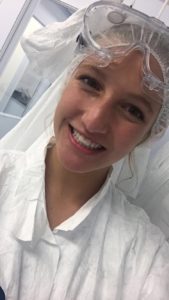

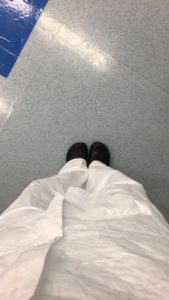
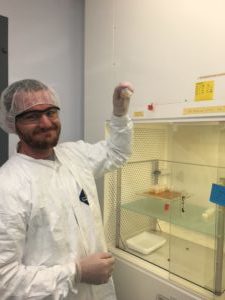
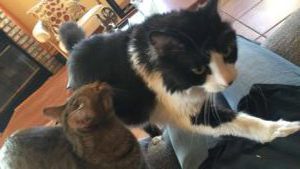
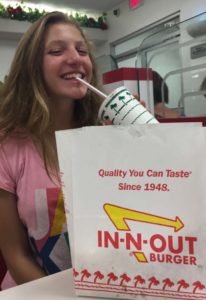
Thanks for your fresh perspective, including the mix of work and recreational events.
You received a generous welcome from your mentor, the Anbar Lab staff, and host family because of your adventurous spirit, desire to learn, and dazzling smile. In other words, you deserve it. I’m glad you’re enjoying your summer and the opportunities afforded by Pinhead and your parents. Your presentation to the hometown crowd will be worth hearing.